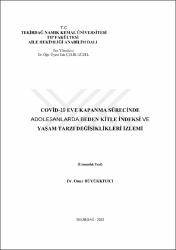| dc.contributor.advisor | Güzel, Eda Çelik | |
| dc.contributor.author | Büyükkıyıcı, Onur | |
| dc.date.accessioned | 2023-04-27T20:41:18Z | |
| dc.date.available | 2023-04-27T20:41:18Z | |
| dc.date.issued | 2022 | |
| dc.identifier.uri | https://tez.yok.gov.tr/UlusalTezMerkezi/TezGoster?key=5XiSE4yCP_gmnukpMEp65VuBMaaQKUGaZR-bXNzmy0QjB4GXv0f7EcYrKL-hRMW_ | |
| dc.identifier.uri | https://hdl.handle.net/20.500.11776/11711 | |
| dc.description.abstract | Adolesanlar arasında obezite prevalasnsı son 30 yılda gittikçe artmaktadır. Adolesan çağda görülen obezite yetişkinliğe geçildiğinde de devam etmesiyle mortalitesi ve morbiditesi yüksek pek çok hastalığa neden olmaktadır. Covid-19 pandemesi nedeniyle hayatımıza giren sosyal izolasyon nedeniyle pek çok bireyin fiziksel aktivite miktarı kısıtlanmıştır ve obezite riski artmıştır. Bu çalışmada adolesanların Covid-19 eve kapanma sürecinde beden kitle indeksi ve yaşam tarzı değişikliklerinin tespit edilmesi amaçlanmıştır. Çalışmaya Tekirdağ Namık Kemal Üniversitesi Tıp Fakültesi Hastanesi Aile Hekimliği Polikliniği'ne Haziran 2020'de başvuran adolesanlar dahil edilmiştir. Katılımcılara sosyodemografik, antropometrik bilgilerini ve beslenme – egzersiz davranışlarını inceleyen ölçek ön test ve son test şeklinde uygulanmıştır. Katılımcıların sosyodemografik özellikleri, yaşam tarzı ve beden kitle indeksi değişiklikleri değerlendirilmiştir. Katılımcılar %64,9'u kız (n: 50), %35,1'i (n:27) erkek olmak üzere 77 kişiden oluşmaktadır ve yaş ortalaması 16,64 ± 0,16 idi. Katılımcıların sokağa çıkma kısıtlamasının başındaki ve sonundaki beden kitle indeksi persantil ortalaması arasında istatiksel açıdan anlamlı fark mevcuttur (p:0,014) ancak serbest zamanın başındaki ve sonundaki beden kitle ortalamasında istatiksel açıdan anlamlı fark saptanmamıştır (p:0,372). Katılımcıların %57,1'i pandemiden sonra egzersiz davranışlarının azaldığını belirtmiştir. Sokağa çıkma kısıtlaması dönemindeki ekran başında geçirilen süre kısıtlamalar kalktıktan sonra azalmıştır (p:0,043). Araştırmamızda sokağa çıkma kısıtlamasında daha fazla kilo aldığı gösterilmiştir. Adolesanlar arasında her geçen gün artmakta olan obezite prevalansı, sokağa çıkma kısıtlamalarıyla daha da artma riski altındadır. Covid-19 pandemisiyle adolesanlarda obeziteyle mücadele farklı bir boyut kazanmış olup, özellikle risk altındaki gruplara daha fazla odaklanılmalıdır. | en_US |
| dc.description.abstract | The prevalence of obesity among adolescents has been increasing in the last 30 years. Obesity seen in adolescence causes many diseases with high mortality and morbidity as it continues into adulthood. Due to the social isolation that has entered our lives due to the Covid-19 pandemic, the amount of physical activity of many individuals has been limited and the risk of obesity has increased. In this study, it was aimed to determine the body mass index and lifestyle changes of adolescents during the Covid-19 lock-in period. Adolescents who applied to Tekirdağ Namık Kemal University Medical Faculty Hospital Family Medicine Outpatient Clinic in June 2020 were included in the study. The scale examining the participants' sociodemographic, anthropometric information and nutrition-exercise behaviors was administered as a pre-test and post-test. The sociodemographic characteristics, lifestyle and body mass index changes of the participants were evaluated. Participants consisted of 77 people, 64.9% female (n: 50), 35.1% (n: 27) male, and the mean age was 16.64 ± 0.16. There is a statistically significant difference between the participants' body mass index percentile mean at the beginning and end of the curfew (p:0.014), but no statistically significant difference was found in the body mass mean at the beginning and end of the free time (p:0.372). 57.1% of the participants stated that their exercise behaviors decreased after the pandemic. The time spent in front of the screen during the curfew period decreased after the restrictions were lifted (p:0.043). In our research, it was shown that he gained more weight in the curfew. The prevalence of obesity, which is increasing day by day among adolescents, is at risk of further increasing with curfews. With the Covid-19 pandemic, the fight against obesity in adolescents has gained a different dimension, and more focus should be placed on groups at risk. | en_US |
| dc.language.iso | tur | en_US |
| dc.publisher | Tekirdağ Namık Kemal Üniversitesi | en_US |
| dc.rights | info:eu-repo/semantics/openAccess | en_US |
| dc.subject | Aile Hekimliği | en_US |
| dc.subject | Family Medicine | en_US |
| dc.subject | Çocuk obezitesi | en_US |
| dc.subject | Pediatric obesity | en_US |
| dc.title | COVID-19 eve kapanma sürecinde adolesanlarda beden kitle indeksi ve yaşam tarzı değişiklikleri izlemi | en_US |
| dc.title.alternative | Follow-up of body mass index and lifestyle changes in adolescents during the COVID-19 lockdown | en_US |
| dc.type | specialistThesis | en_US |
| dc.department | Enstitüler, Tıp Fakültesi, Aile Hekimliği Ana Bilim Dalı | en_US |
| dc.identifier.startpage | 1 | en_US |
| dc.identifier.endpage | 113 | en_US |
| dc.institutionauthor | Büyükkıyıcı, Onur | |
| dc.relation.publicationcategory | Tez | en_US |
| dc.identifier.yoktezid | 712781 | en_US |



















